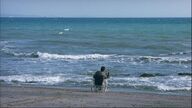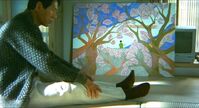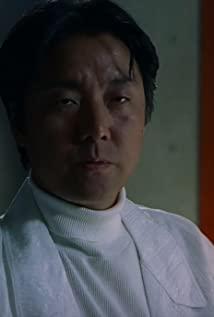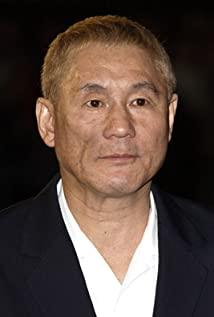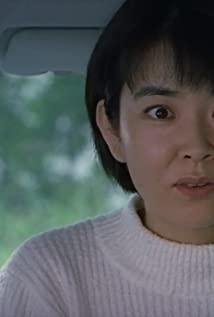This film not only tells about the last life journey of Mr. Yamada and his wife, but also reflects the change of mind of director Takeshi Kitano after the car accident. In the 22 paintings drawn by Takeshi Kitano interspersed in the film, we can see his in-depth thinking about life, family, life and death. In the movie, these paintings and the plot echo each other and become a key key to entering the spiritual world of Kitano Takeshi.
1 Qingshen and Poseidon
The picture behind Mr. Yamada in the screenshot is a narrative focus of the film. The two gods in the painting are from Japanese myths and legends. The one on the left is the god of blue, and the one on the right is the god of the sea with a scoop. Qingshen is the master of the "Blue Island" in Japanese folklore, and the sea god is the god who dominates the sea. Japanese who believe in Shinto believe that after death, people will go to a place called Aoshima Island deep in the sea, and continue to live there. When night falls, a golden light glows in the caves on the island, where the souls of the dead wander around, feeding on the grass and dew between the stone crevices. From the legend of Qingshen and Poseidon, we can see the deep-rooted complex of "the other side of the world" in Japanese culture. It can be said that this kind of reverie about the other side of the world runs through the film from beginning to end. Even Yamada's suicide by using a pistol at the beach stems from the "other side" complex: he believes that death is a kind of relief, the beginning of a journey from this side to the other side.
2 The sea: a symbol of liberation
If you think about it, the characters in Takeshi Kitano's movies have committed suicide by the sea more than once. In addition to this film "Fireworks", there is Muragawa in "Little Sonata", and Otomo in the latest "Extremely Evil 3", these characters are all men who are struggling in the turbid world, with "the seaside Suicide" is a ritual to say goodbye to the past life and the past.
Going deeper, the sea that appears in Takeshi Kitano’s series of films is not only in his heart, but also a belief in the other side of the world hidden in the depths of Japanese culture. As the opposite of earthly life, it symbolizes worldly life. liberation in.
However, having said that, "liberation" is not a choice that can be made lightly. Often, a person has lost a lot of things before he begins to seriously think about this issue. Just like the protagonist, Mr. Yamada, he not only lost his career, but also his family. When people reach middle age, they suddenly realize that they have nothing. At this moment, the confusion of "life and death" will suddenly become an unavoidable problem. Thinking about these questions becomes the beginning of the search for liberation.
At the same time, another deep-rooted contradiction in human nature will emerge at this stage, that is: a person can live realistically, but he is full of excessive imagination when thinking about death.
This kind of contradiction is vividly manifested in Mr. Yamada. His wishful thinking about life and death should have harmed him, otherwise Yamada would not have committed suicide by the sea. Yet until the end of his life, he still did not feel the transcendent relief of dying. In the imaginary world on the other side, there is no news, only endless panic.
Pay attention to the director's camera language at this time: the side profile of the kite with its wings torn off describes Mr. Yamada's lost faith. After two bangs, the camera stayed on the endless sea level for a long time, and finally switched to the sluggish face of the little girl who played back the kite. In her confused and sullen expression, what is reflected is the unquestionable objectivity, self-concealment and authenticity of death. It can make the audience feel that Mr. Yamada and his wife did not seem to have embarked on a satisfactory return journey, but death is still an eternal mystery.
Because of the human instinct to avoid death, we have to give death a very romantic meaning. But only by truly experiencing death, will one realize sadly that death is death, and nothing else. Probably this is how Kitano Takeshi felt in the car accident.
As we all know, Takeshi Kitano's car accident experience in 1994 gave birth to the filming of the movie "Hana". Looking back on the past, Kitano Takeshi commented on himself: "The car accident made me realize that fate is not something that I can control. No matter what kind of fate is waiting for you, you can only accept it silently. I don't want to say anything pretty. For example, "I am ready to die anytime, anywhere", but I have the kind of indifference that I can die anytime."
It can be said that the car accident subverted Kitano Takeshi's biased cognition of death. This unforgettable experience also made him understand how easy it is for unrealistic fantasies about death to fall into a ridiculous situation of self-pity and self-pity.
The ridicule of the mentality of "wishful thinking and self-pity" has gradually been integrated into the narrative style of Kitano Takeshi's films. The protagonists under his lens often start from a very high spiritual world, but then take a step forward. But fell into the naive process of practice. Not only the suicide of the Yamada couple at the beach in "Fireworks", but also the poor artist in "Achilles and the Turtle" played by Takeshi Kitano. In Takeshi Kitano's films, we can always see too many people who are stuck in the same place. They are trapped in the gap between their subjective beliefs and objective reality. Their behaviors seem ridiculous, but they are full of a different kind of sadness.
However, Mr. He Du is a rare exception.
3 Yamada and He Du's different life
If the lost Mr. Yamada is the self before the car accident in Takeshi Kitano's eyes, then the character of Mr. He Du reflects the change of Takeshi Kitano's mentality after the car accident. He Du's mental journey of enlightenment and Yamada's experience of getting lost have been carefully arranged by the director on the same timeline. In the parallel narrative of the two characters, there are three important overlapping nodes:
The first node: overlooking the other side, the beginning of the journey.
When Mr. Yamada and his wife started their journey to the Snow Country, Mr. He Du also created a work of looking at the other side by the sea in a quiet small room. For both characters, this is the beginning of an attempt to "find the other side."
The second node: reflection on lost family life, fireworks in the night sky
The camera switched from the Yamada couple watching fireworks to Mr. He Du's painting of the whole family enjoying fireworks. This is the second node where Yamada and He Du overlap each other.
If Mr. Yamada under the fireworks at night is more sad and reluctant for his family, then in Mr. He Du's paintings, we can see that he has thought deeply about what he has lost. This can be seen in three paintings:
In the first painting, which is the above work of the family admiring fireworks, he reflects on the beauty and shortness of family life;
In the second painting, in the scene of watching the starry sky, he re-examines the insignificance of family in the universe.
The second painting, in the painting of huge waves by the sea, he reflects on the impermanence of the world and the fragility of family members (through the plot of the movie, we can know that his daughter and wife, after learning that he is disabled for life, the first away from him for a while).
Mr. He Du looked at his past like this, and gradually began to watch from the sidelines, letting go of his past attachments with a detached attitude. And Mr. Yamada, because of his reluctance to part with his beloved wife, gradually lost and gradually went astray. From this point of view, perhaps the real liberation is not a formal journey, but a kind of instant awareness, a detachment from the shackles of love in the world.
The third node: farewell to this world, cherry blossoms, fleeting life, liberation
When Mr. He Du painted a man kneeling under a cherry tree and about to commit suicide with a knife, Mr. Yamada's wife also resolved to bid farewell to her husband forever, and lived alone in a hotel until the end of her life.
There is one element in common in both scenes: cherry blossoms.
The background of Mr. Yamada's wife registering the photo at the hotel is also a painting related to cherry blossoms.
Cherry blossoms are flowers with a short flowering period. At the moment of blooming, the flowers are splendid, warm and magnificent. But it only takes a gust of wind to blow, and it falls silently like snowflakes. The withering beauty of cherry blossoms coincides with the unique perspective of Japanese people's view of life. They believe that beautiful things are short-lived and fleeting. Compared with the blooming cherry blossoms, the petals fluttering in the wind are more moving, which is a manifestation of the beauty of impermanence.
From this point of view, the two paintings related to cherry blossoms imply that Yamada and He Du are about to bid farewell to the world in their own way.
Yamada kills the underworld that haunts him, signaling that his life is coming to an end. He Du splashed red paint on the last painting, perhaps because he no longer needed to paint, because he was really relieved.
Pay attention to the close-up of three ugly dolls on the tatami at this time, this is the image of the family in Mr. He Du's eyes. The doll is made of paper, so if you hold it in your hand, it must be light and weightless. It is like a lost, insignificant family, whether it was full of joy and affection, or the resentment, helplessness, and despair that were abandoned after being disabled. In the eyes of Mr. He Du at this time, I am afraid that it has already turned into a wisp of light passing by.
This movie tells us how a person should learn how to face loss.
Watching Yamada go his own way, he wants to continue the warmth he once had, even at the cost of destroying it together. This infatuation will inevitably make the audience feel sad, but is it not a cowardice of self-defeating? The beauty of fireworks lies in their fleeting blooms, and the poetic meaning of life is the feeling of helplessness as the years go by. The experience of the Yamada couple has shown us how a too-good relationship can make people fall into depression. I think Yamada's story reveals Kitano's complicated feelings for his wife.
In fact, this feeling was also revealed in Kitano Takeshi's autobiography "The Rest of Your Life":
"Just like "Bad Boy's Sky" is a kind of self-recovery for me, "Fireworks" is an apology to my woman and my lovers. It can be said that I have long been prepared to die. , it's okay to even be a robber. The wife's words...if only she were dead. It doesn't matter what the wife cares about her. It's just that she didn't die so early. While making this movie, I organized the wife's sudden death association.' There is no one who is useless like me. It is still some savings. As long as my wife dies, I can use it all." But how can it be so easy to die. I am unlucky.… I can't say anything. I can't leave my wife at all!"
Du Zhong: Interior designer, likes to watch movies and read books.
View more about Fireworks reviews



